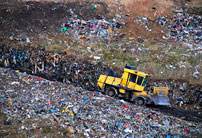- MENU
- HOME
- SEARCH
- WORLD
- MAIN
- AFRICA
- ASIA
- BALKANS
- EUROPE
- LATIN AMERICA
- MIDDLE EAST
- United Kingdom
- United States
- Argentina
- Australia
- Austria
- Benelux
- Brazil
- Canada
- China
- France
- Germany
- Greece
- Hungary
- India
- Indonesia
- Ireland
- Israel
- Italy
- Japan
- Korea
- Mexico
- New Zealand
- Pakistan
- Philippines
- Poland
- Russia
- South Africa
- Spain
- Taiwan
- Turkey
- USA
- BUSINESS
- WEALTH
- STOCKS
- TECH
- HEALTH
- LIFESTYLE
- ENTERTAINMENT
- SPORTS
- RSS
- iHaveNet.com
Cynthia Ramnarace

Two nights a week, my husband diligently collects the household trash and recycling and places it at the curb.
In the morning, my 3-year-old son, Miles, runs to the window at the sound of the garbage truck's loud engine, excited to watch this mechanical behemoth crunch and smash our mushy banana peels, empty strawberry cartons and broken toys.
Within seconds, he's back to playing with his trains. But as that annoyingly loud truck rolls down the street, I often wonder: Where does all that unwanted stuff go?
It turns out that our trash is hauled far, far from our home in Queens, N.Y. According to the New York City Department of Sanitation, 93 percent of the area's trash is hauled to landfills within a 200-mile radius. Thank you, upstate New York, New Jersey and Pennsylvania, but I do wish we didn't have to burden you so. After all, that's 61,000 tons of trash per week!
Nationwide, Americans produce 243 million tons of waste per year -- that's 4.3 pounds per person, per day, according to the Environmental Protection Agency. About one-third of that waste is recycled or composted, more than half winds up in a landfill, and about 12 percent is incinerated.
Why aren't we recycling more?
"Only about half the country has access to residential curbside recycling programs," explains Steve Thompson, executive director of the Curbside Value Partnership, which works to grow recycling programs around the country. "There's also a lot of confusion about what can and can't be recycled; and in rural areas especially there are recycling centers you can drive to, but it takes more energy on your part to make it happen."
In most parts of the country, recyclables are taken to a sorting facility where "air knives, screens and some physics" combine to separate items in preparation for resale, explains Thompson. Magnets remove steel. A reverse magnet moves aluminum in another direction. Corrugated cardboard is baled. Aluminum is the most in-demand recyclable, says Thompson, since it can easily be recycled back into another aluminum product, like a soda can. Corrugated cardboard is in high demand in China, where it's used to build new shipping boxes.
Municipal composting is another good way to help to cut down on waste. New York City, like many parts of the country, brings yard waste and Christmas trees to composting sites. Once these items decompose, the resulting dirt and mulch is used in parks, schools and community gardens.
Composting and recycling take some of the guilt out of my trash-rich life. But like many people, I realize that what would really make me feel better would be knowing that my trash cans are the lightest on the block. The New York area has something called the New York City Zero Waste Campaign idea -- the name says it all, and it's not just for big city areas. Sure, recycling and composting everything you use and generating less waste overall by 2024 is an ambitious goal, but it's worth a try. Even if you don't get all the way there, you'll still cut down on a lot of waste.
Learning to compost -- even just a little bit -- is a great first step. Another recommendation from the Zero Waste Campaign is to choose goods that use the least packaging when shopping. And instead of buying new items, try renting or borrowing things like tools when you need them. You can also skip those single-use plastic bags and pack your kids' lunches in reusable containers, giving them grapes or bananas to snack on instead of yogurt from a plastic tube or carton.
If you're feeling overwhelmed, look to those parts of the country that are serving as role models for the rest of us: "Oregon, Minnesota and Vermont have some of the most active recycling programs," says Thompson. "Culturally, they recognize that recycling makes a huge difference. They got the message early: Recycling is the easiest thing someone can do to reduce their footprint."
Cynthia Ramnarace is a freelance writer in Queens, N.Y. She is a regular contributor to iVillage.com and AARP Bulletin. Her work also appears frequently in American Baby and Kiwi magazines.
Available at Amazon.com:
Hot Time in the Old Town: The Great Heat Wave of 1896 and the Making of Theodore Roosevelt
American Insurgents, American Patriots: The Revolution of the People
Broke, USA: From Pawnshops to Poverty, Inc.How the Working Poor Became Big Business
Were You Born on the Wrong Continent?: How the European Model Can Help You Get a Life
The Disappearing Center: Engaged Citizens, Polarization, and American Democracy
The Virtues of Mendacity: On Lying in Politics
Bush on the Home Front: Domestic Policy Triumphs and Setbacks
The Political Fix: Changing the Game of American Democracy, from the Grassroots to the White House
Courage Grows Strong at the Wound
WORLD | AFRICA | ASIA | EUROPE | LATIN AMERICA | MIDDLE EAST | UNITED STATES | ECONOMICS | EDUCATION | ENVIRONMENT | FOREIGN POLICY | POLITICS
Where Does Garbage Go?